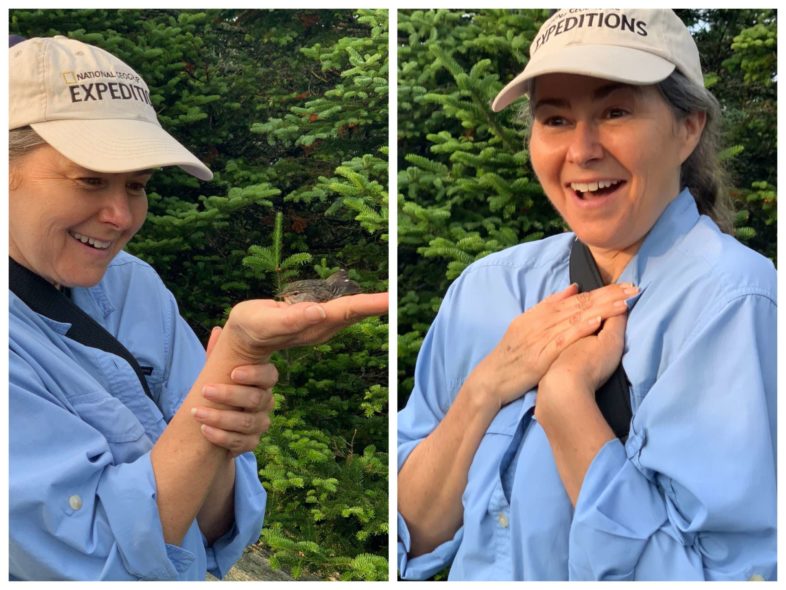
A life-altering moment for VCE friend Jennie Savage as she releases a banded female Blackpoll Warbler on Mt. Mansfield, 6 July 2021. © Susan Hindinger
Free-flying juveniles. Molting adults. Regressing brood patches. Subdued, sporadic song. Signs of seasonal change punctuated VCE’s early July visit to Mt. Mansfield. Summer may be at its peak for us humans, but the avian breeding season marches inevitably on. Birds nesting on mountaintops like Mansfield face a compressed period of time in which to establish territories, mate, build nests, lay eggs, successfully fledge nestlings, raise fledglings to independence, undergo their annual molt, and prepare for southward migration. All of these energy-demanding activities must be fit in over a mere four months, or less—natural selection places a premium on scheduling them rapidly and efficiently.
Taking advantage of the week’s only forecasted window of (mostly) dry weather, the VCE team arrived on Tuesday evening, promptly setting our 25 mist nets in the usual locations, watching radar that looked threatening in every direction. Thankfully, rain held off until we had closed nets, after banding 10 birds, and were ready to grab a few hours of sleep. However, no splaying out sleeping bags under the stars this week; 11 of us—VCE staff, summer interns, and visitors—crammed ourselves into the backs of vehicles (I never thought I’d fit into my 2010 Prius…) or tents, as rain drummed over our heads.
The precipitation passed soon after it began, and we opened nets in the pre-dawn under cloudy, cool conditions. A steady but manageable stream of captures followed, never overwhelming us, and allowing adequate time to mentor our summer interns, Eileen Fitzgerald and Ani MacMannon, as well as showcase each bird to our eager visitors. By mornings’ end, we had banded half a dozen juveniles of 3 species, caught several adults in early flight feather molt, and recorded many fading brood patches and cloacal protuberances. An adult Wood Thrush and our sixth Black-throated Green Warbler—a single-season record—were the only real surprises.
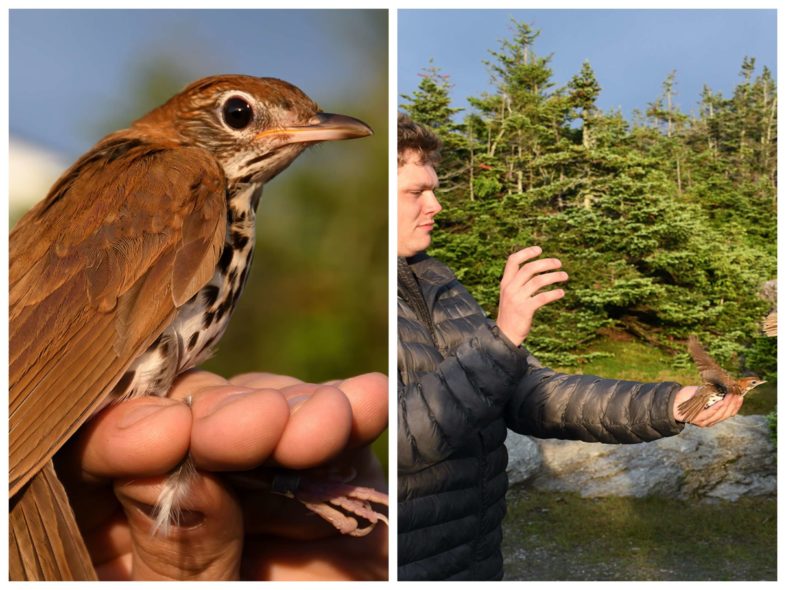
An adult Wood Thrush (left)—likely a failed breeder or early post-breeding disperser—made a rare appearance in VCE’s mist nets; Kevin Tolan releases it moments later (right). 7 July 2021, Mt. Mansfield, VT. © Michael Sargent
Our final tally of 54 captures included:
Yellow-bellied Flycatcher — 1 new adult of unknown sex
Winter Wren — 1 within-season recapture; female w/full brood patch
Bicknell’s Thrush — 15 (9 males, 6 females): 5 new, 3 returns (1 male from 2013, 2 from 2018), 7 within-season recaptures
Swainson’s Thrush — 1 new female with full incubation/brood patch
Wood Thrush — 1 new adult of unknown sex
American Robin — 2 new: full-grown juvenile and female w/ fully-developed incubation patch
Dark-eyed Junco (Slate-colored) — 6 (5 free-flying juveniles, 1 return male from 2020)
White-throated Sparrow — 5 (4 new, 1 return male from 2020)
Blackpoll Warbler — 13 (3 new, 2 return males from 2018 and 2020, 6 within-season recaptures)
Yellow-rumped Warbler (Myrtle) — 8: 5 new (including a dependent stub-tailed juvenile), 1 return male from 2018, 2 within-season recaptures
Black-throated Green Warbler — 1 new female with regressing brood patch
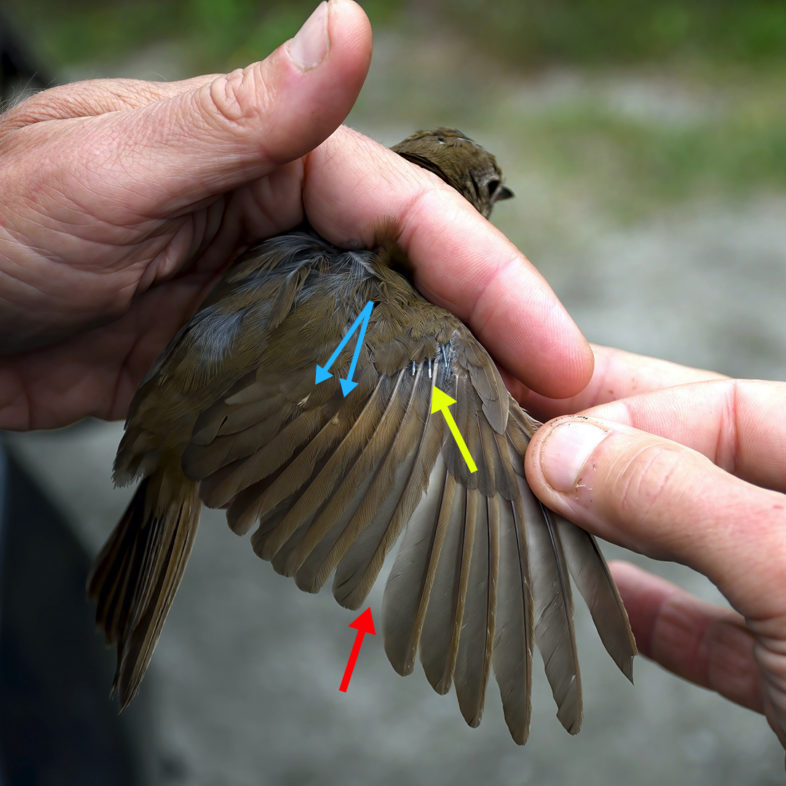
A yearling male Bicknell’s Thrush—identifiable by its two retained juvenal inner greater coverts (blue arrows)—in early stages of flight feather molt, with primaries #1-3 missing (red arrow denotes gap in wing) and its outer greater coverts in pin (yellow arrow). Note the broken outermost primary, highlighting the need for migratory songbirds like Bicknell’s Thrush to annually replace worn, degraded feathers. 7 July 2021, Mt. Mansfield, VT. © Michael Sargent
VCE’s new study to investigate late winter movements of Bicknell’s Thrush (BITH) on the species’ Caribbean wintering grounds took a solid step forward, as we affixed an additional 6 tiny GPS backpacks to adult birds. One of these was another venerable old-timer—male #193176718, whom we banded on 16 July 2013 as a 2+ year-old, indicating that he was hatched in 2011 or earlier and is now at least a 10-year veteran. Interestingly, this bird’s capture history suggests that he is either adept at avoiding our nets or spends much time outside our main netting area each year: following his original 2013 capture, we missed #193176718 in 2014, captured him once in mid-June of both 2015 and 2016, missed him in 2017, caught him in early June of 2018, missed him completely in 2019 and 2020, then reunited with him this week! There can be little doubt that he has been present on Mansfield in every one of those summers; we’ll need to expand our netting efforts in 2022 to increase the odds of recapturing #193176718 and others of his fellow GPS-tagged BITH.
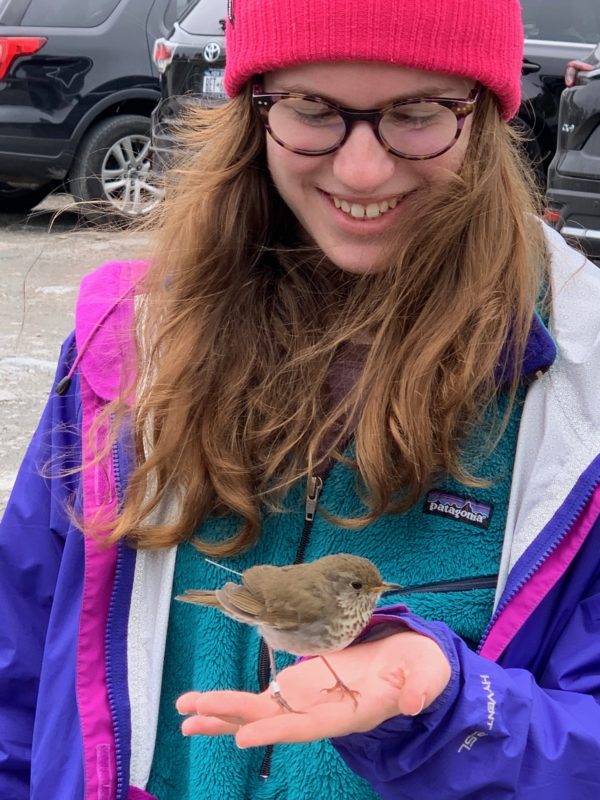
Dory Hindinger with a GPS-tagged adult Bicknell’s Thrush, apparently in no hurry to leave her hand. 7 July 2021, Mt. Mansfield, VT. © Susan Hindinger
Our goal of affixing these miniature backpacks to 40 adult BITH before our field season ends now seems within reach. We have so far fitted 31 adults (22 males, 9 females) with GPS tags and have 4 weekly sessions remaining, plus our annual mid-September “wrap-up” visit. Encouragingly, we recaptured another 5 previously tagged birds (3 males, 2 females) on this visit, and all were in robust condition.
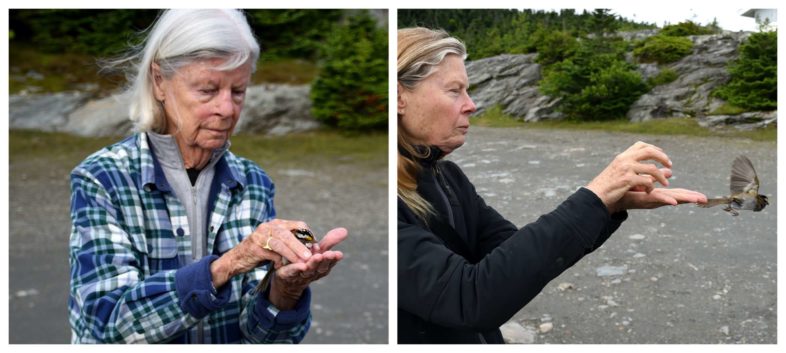
Birgit Deeds (left) and her daughter Kim Findlay (right) focus intently on the release of two banded White-throated Sparrows. 6 July 2021, Mt. Mansfield, VT © Michael Sargent
Finally, we were a diverse group of 15 participants that included VCE staff, interns, colleagues, and friends. The opportunity to engage people in this long-term project—and to introduce them to the wonders of banded birds “up close and personal”—provides meaning, inspiration, learning, and camaraderie for all involved. Uniting people and science for conservation…
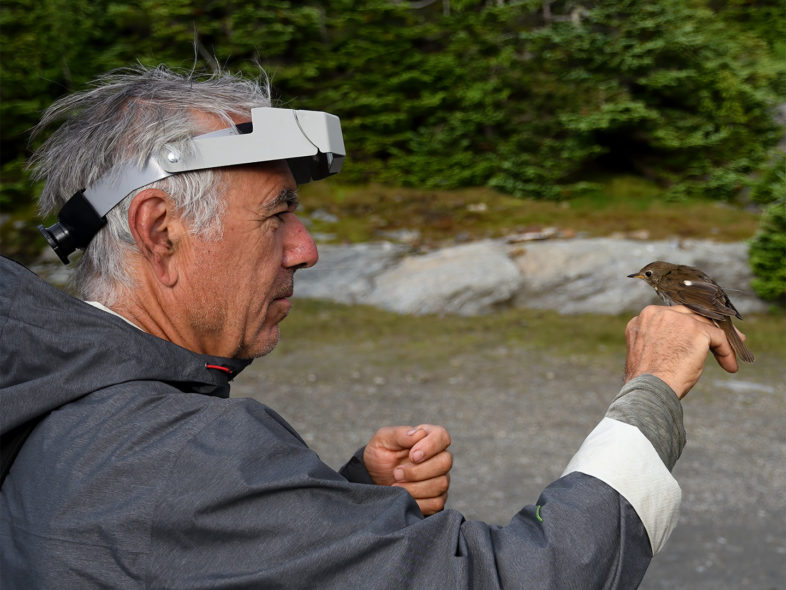
Longtime VCE colleague and friend Paul Wieczoreck with a GPS-tagged Bicknell’s Thrush just prior to release, 7 July 2021, Mt. Mansfield VT. Paul’s strange headgear, appropriated temporarily from the VCE project leader, is what aging bird banders use to read band numbers… © Michael Sargent

Just wonderful pictures and lots of helpful information in this posting. Thank you!
Thank you Chris and your hardy group for this ‘encouraging’ report, it’s really brilliant to read words like ‘encouraging’ for netted Bicknell’s numbers! Hearing them sing up there years ago was a true thrill. The people-bird encounters photos quite moving.
So interesting and informative. Thank you for the work and for the report and photos.